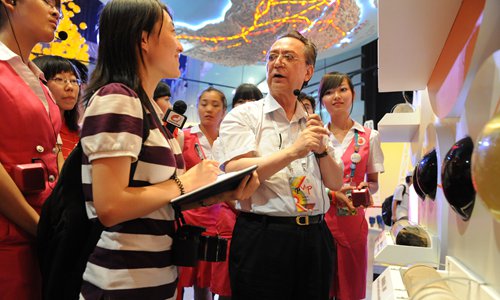HOME >> CHINA
Scientist Wang Demin helps China’s first major oilfield produce for half century
Source:Global Times Published: 2019/6/27 19:38:40

Wang Demin, an academician at the Chinese Academy of Engineering, shares his knowledge of oil. Photo: IC
Photos of Wang Demin, an academician at the Chinese Academy of Engineering, as a young man recently caused a stir among the younger generation on Chinese social media for his handsome appearance. When people learn about his contribution to China's petroleum industry, their respect for him increases.
Wang, 82, is also a professor of the School of Petroleum Engineering under Northeast Petroleum University, in Daqing, Northeast China's Heilongjiang Province, and the founder of the stratified development of petroleum and chemical flooding technology in China.
In the early 1960s, he came up with formulae for formation pressure in the Daqing oilfield named the "Songliao method." The occurrence of errors was reduced fivefold compared with previous calculation methods, greatly improving the precision of calculations of the underground pressure of oilfields.
Wang also led a scientific project which solved the problem of dropping oil production and increasing water content that the oilfield encountered in 1969.
After a year's efforts and more than 1,000 experiments, Wang invented China's first eccentric injection mandrel and production mandrel, which improved oil production efficiency in the field fivefold, and helped the oil fiend to achieve long-term stable operation.
On April 12, 2016, asteroid 210231 was given the name "Wang Demin."
Life options
Wang was born in Tangshan, North China's Hebei Province in 1937. His father, who studied medicine in the US, was a doctor in the Linxi coal mine hospital in his early years. His mother was from Switzerland and took care of the family at home.
In 1955, Wang was admitted to the department of oil production under the Beijing Petroleum Institute, which was renamed China University of Petroleum in 2005, with the aim of rejuvenating China through science and technology.
Wang graduated from the Beijing Petroleum Institute in 1960.
It was during this transitional period for China's petroleum industry that a massive oilfield was discovered in Daqing.
Although Wang's family was fairly well off, he resolutely ignored the objections of his relatives and gave up the opportunity to stay and teach at school. Instead, he went to Daqing to work in the pressure measurement group of the oilfield geology room.
First achievements
Working conditions were harsh in the early days of the development of the Daqing oilfield. After arriving in Daqing, Wang lived in a cowshed and burned crude oil for heating at night. The smoke blackened his skin. It was in this bleak environment that Wang began his career in scientific research.
Special instruments were lowered over 1,000 meters into the wells to measure the pressure of the oil layer once a month at that time. Oil would only come out at 120 atmospheres. If the pressure was below 100 atmospheres, gas came out. If the pressure was too high, water came out instead of oil.
At that time, the "Homer method" was used worldwide for calculating oil pressure. However, this method left great potential for error, making it difficult to obtain reliable information on conditions in the Daqing oilfield.
In addition, the method was extremely labor intensive, with workers carrying winches weighing more than 50 kilograms back and forth for testing, and working until after midnight.
Wang, then only 24 years old, was determined to invent a new test calculation method to solve these problems.

A photo of Wang's student registration card Photo: IC
He majored in oil production, and well testing was just one of 32 subjects he studied. He studied English at school but learned Russian by himself in order to use Russian sources to master mathematical derivation.
After working for more than five months, on February 17, 1961, he deduced the oil well pressure calculation formula in line with the actual situation of the Daqing oilfield according to the principle of unstable heat conduction.
After appraisal, the new calculation method was named the "Songliao method," and was soon applied to the entire oilfield. The Songliao method was proven to be twice as accurate as the Homer method.
In the 1970s, the water content of Daqing oilfield reached levels of between 20 percent and 70 percent, so new technologies had to be adopted to meet production needs.
A quarter of the Daqing oilfield is made up of a layer of thin oil only 0.2 to 0.5 meters thick. This thin oil had not previously been useable.
In order to produce more oil from the thin oil layer, cracks that are 100 times wider than the previous ones should be made through injecting high-pressure liquid into the layer.
The difficulty lies in fracturing only the required oil layer, which technically requires that a 0.2-meter-thin oil layer be shot more than 1,000 meters underground with a depth error of less than 0.02 percent.
It was harder than being a sharpshooter. However, Wang and his colleagues once again solved the problem.
Exploiting these thin oil layers could increase oil production by over 50 million tons each year. After this technique was popularized in Daqing, output saw an increase of 700 million tons, equivalent to discovering another large oilfield.
In the middle and late 20th century, foreign experts predicted that the Daqing oilfield could only produce 50 million tons of oil annually until 1995.
But Wang believed that technological innovation and new oil extraction technologies could keep Daqing's oil production high and stable for longer.
The average oil recovery rate around the world was 33 percent at that time, while that of the Daqing oilfield had reached over 40 percent. Everyone was praising Daqing, but Wang had been working on chemical flooding 10 years earlier in order to get more oil out of the remaining 60 percent of the reservoir.
Many countries represented by the US did not use chemical flooding at that time, believing it was a difficult technology to master.
The Daqing oilfield had been putting chemical flooding into use since 1996, gaining economic benefits of more than 10 billion yuan ($1.5 billion). The technique, known as polymer flooding, increased Daqing's production rate to 50 percent, a relative increase of 25 percent.
Although Wang doesn't like living in cold climates, he loves the Daqing oilfield, where he has been all his life. He believes it has been a privilege to devote his life to such a large oilfield and the country's petroleum industry.
Newspaper headline: Striking black gold
Posted in: PROFILE